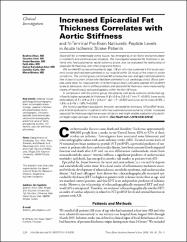Increased Epicardial Fat Thickness Correlates with Aortic Stiffness and N-Terminal Pro-Brain Natriuretic Peptide Levels in Acute Ischemic Stroke Patients

Göster/
Tarih
2016Yazar
Altun, İbrahimÜnal, Yasemin
Başaran, Özcan
Akın, Fatih
Emir, Gülser Karadaban
Kutlu, Gülnihal
Biteker, Murat
Üst veri
Tüm öğe kaydını gösterÖzet
Epicardial fat, a metabolically active tissue, has emerged as a risk factor and active player in metabolic and cardiovascular diseases. We investigated epicardial fat thickness in patients who had sustained an acute ischemic stroke, and we evaluated the relationship of epicardial fat thickness with other prognostic factors. We enrolled 61 consecutive patients (age, >= 18 yr) who had sustained a first acute ischemic stroke and had been admitted to our hospital within 24 hours of the onset of stroke symptoms. The control group comprised 82 consecutive sex-and age-matched patients free of past or current stroke who had been admitted to our cardiology clinics. Blood samples were taken for measurement of N-terminal pro-brain natriuretic peptide (NT-proBNP) levels at admission. Aortic stiffness indices and epicardial fat thickness were measured by means of transthoracic echocardiography within the first 48 hours. In comparison with the control group, the patients with acute ischemic stroke had significantly higher epicardial fat thickness (4.8 +/- 0.9 vs 3.8 +/- 0.7 mm; P < 0.001), lower aortic distensibility (2.5 +/- 0.8 vs 3.4 +/- 0.9 cm(2).dyn(-1); P < 0.001) and lower aortic strain (5.5% +/- 1.9% vs 6.4% +/- 1.8%; P=0.003). We found a significant association between epicardial fat thickness, NT-proBNP levels, and arterial dysfunction in patients who had sustained acute ischemic stroke. Increased epicardial fat thickness might be a novel risk factor and might enable evaluation of subclinical target-organ damage in these patients.

















